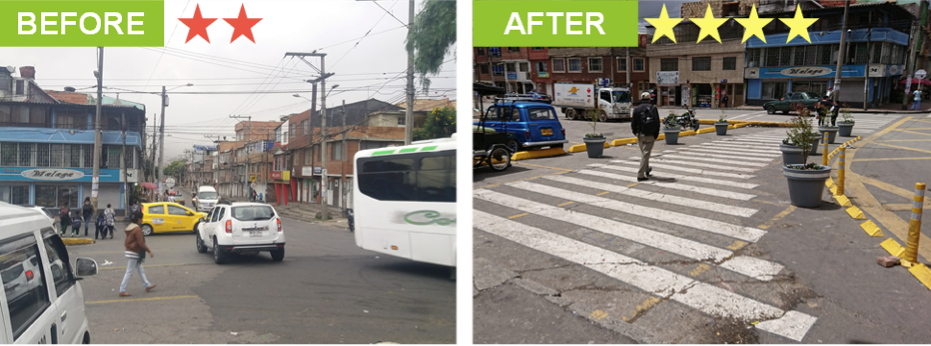IN LIFE YOU MUST HAVE VISION…
There’s a lot more to the concept of Vision Zero than “just” drastically reducing road deaths. Its principles also include drastically reducing the causes of road deaths and, just as crucially, implementing far-reaching educational programmes for children, the road users of the future. Intertraffic spoke with Peter van der Knaap of SWOV, European Cyclists Federation Alexander Buczyński, Rafaela Machado of IRAP, Porte Alegre of Machado and UN Representative Natalie A. Draisin in the subject of road safety to ascertain what has been happening over the past year and just how tomorrow’s drivers are going to fare.
Vision Zero
Vision Zero is a multi-national road traffic safety project that aims to achieve a highway system with no fatalities or serious injuries involving road traffic. It started in Sweden and was approved by their parliament in October 1997. A core principle of the vision is that 'Life and health can never be exchanged for other benefits within the society' rather than the more conventional comparison between costs and benefits, where a monetary value is placed on life and health, and then that value is used to decide how much money to spend on a road network towards the benefit of decreasing risk.
Vision Zero was introduced in 1995 and over the past 26 years it has been variously adopted in different countries (with Sweden, the Netherlands, Canada, the UK and US the first five to fully embrace the notion), although its description varies significantly. The countermeasures implemented in Vision Zero continue to be education, enforcement and engineering, applied since the 1930s.
The concept of Vision Zero is based on an underlying ethical principle that "it can never be ethically acceptable that people are killed or seriously injured when moving within the road transport system." As an ethics-based approach, Vision Zero functions to guide strategy selection and not to set particular goals or targets. In most road transport systems, road users bear complete responsibility for safety. Vision Zero changes this relationship by emphasizing that both transportation system designers and road users share responsibility.
It’s clearly working. Take the Netherlands as a perfect example. In 1980 there were 1996 people killed on Dutch roads. By 2013 that figure had dipped below 500. Cars are safer, roads are safer… but by the same token drivers have come to rely on the life-saving technology embedded in their vehicles to ensure they emerge intact from dangerous situations that may well have claimed their lives as little as 25 years ago.
Sustainable Road Safety approach
Peter van der Knaap, Managing Director of SWOV Institute for Road Safety Research in the Netherlands, and one of the panellists for Intertraffic’s forthcoming road safety episode of its On Air series on 22 June, a sustainability-led approach is key to the overall success of any scheme designed to save lives.
“The Sustainable Road Safety (SRS) approach of the Netherlands aims to prevent crashes whenever possible and to prevent the risk of serious injury much as possible,” he explains.
“The vision is clear: in a sustainably safe road traffic environment the infrastructural layout considerably reduces the risk of crashes. In case crashes do still occur, the process that determines the crash severity is conditioned in such a way that serious injury is virtually excluded. Protagoras’ assertion that man is the measure of all things is used as the point of departure. Nearly all crashes have their origin in human error. Hence, the purpose is clear:
(1) to reduce the number of errors that are committed by providing clear traffic rules and road design and at the same time; and
(2) to construct infrastructure and vehicles in such a ‘forgiving’ way that errors do no longer have fatal consequences.”
Consequently, such a sustainably safe road traffic system prevents road deaths, serious road injuries and permanent injury by systematically reducing the underlying risks of the entire traffic system.
“Human factors are the primary focus: by starting from the demands, competencies, limitations and vulnerabilities of people, the traffic system can be realistically adapted to achieve maximum safety”
“Human factors are the primary focus: by starting from the demands, competencies, limitations and vulnerabilities of people, the traffic system can be realistically adapted to achieve maximum safety. Like Vision Zero, SRS it is a ‘safe system’ approach that combines the three E’s’: engineering, education and enforcement in a methodical and scientifically based way,” says van der Knaap. “During the past 25 years, the SRS approach has accomplished a small metamorphosis of the physical appearance of the Netherlands. The road network is given a hierarchical structure consisting of access roads, distributor roads and through roads. In addition, literally thousands of roundabouts have been constructed and many separated bicycle paths. Evaluation research proved that SRS helps to save many people from fatal road crashes and severe injuries.”
In 2018, SWOV launched the third edition of the SRS approach, in which five road safety principles are presented:
1. Functionality of roads;
2. (Bio)Mechanics: limiting differences in speed, direction, mass and size, and giving road users appropriate protection;
3. Psychologics: aligning the design of the road traffic environment with road user competencies.
The other two principles are organization principles now:
4. Effectively allocating Responsibility;
5. Learning and Innovation within the traffic system.
“Concerning the design principles, vulnerable modes of transport (pedestrians and cyclists in particular) and the competence of older road users were more explicitly included than before,” van der Knaap adds. “The third edition also pays greater attention to cyclist crashes not involving motorized vehicles. Responsibility is emphasized with respect to the role and potential actions of stakeholders in realizing an inherently safe road traffic system. Herein, the importance is stressed of an in-depth analysis of all fatal road crashes to learn from the things that still go wrong.”
“In the end, every road user – be it schoolchild, commuter, commercial driver or active senior – will come home safely.”
Furthermore, this third edition of the vision calls for a pro-active and risk-based approach, using both crash statistics and road safety performance indicators (or surrogate safety measures) as safety indicators and as a basis for action.
“The aim is to work systematically towards maximum road safety for everybody by means of this third edition of Sustainable Safety, the ultimate ambition being a casualty-free traffic system. In other words, in the end, every road user – be it schoolchild, commuter, commercial driver or active senior – will come home safely.”
Cycling safety: Saddle up
Van der Knaap, somewhat pertinently, mentioned cyclists. Think of the principles of Vision Zero and unless you are a keen, committed cyclist, it’s likely that your first thought is that its main goal is to reduce automotive accidents and resultant KSI statistics. This is certainly not how the European Cyclists’ Federation2018F (ECF) considers Vision Zero, as the organisation’s Infrastructure Officer Alexander Buczyński elucidates.
“Cycling is traditionally perceived as a local and primarily urban mobility issue. Most cycle trips are indeed relatively short and the potential for cycling is highest in densely populated cities. However, across the EU as much as 42% of cyclist fatalities occur outside urban areas which suggests that cycling infrastructure is not only needed in cities,” he says.
“Lots of issues are at play here but an important factor is that cycling is often not considered on the national or European level. This has many consequences, including a lack of coordinated approach, and cycling being forgotten about in major infrastructure projects.
Do you want to know more about the latest developments on Improving Road Safety?
Join Intertraffic ON AIR on the 22nd of June.
Register here >
“Across the EU as much as 42% of cyclist fatalities occur outside urban areas which suggests that cycling infrastructure is not only needed in cities.”
“For example, major roads and railroads belonging to the EU’s Trans-European transport Network (TEN-T) can create dangerous barriers for walking and cycling. In Hungary, the construction of the M5 motorway destroyed an existing cycle path connecting Szeged with neighbouring towns and a part of the international cycle route EuroVelo 13 – Iron Curtain Trail. In Poland, a section of the flagship EU Rail Baltica project cut towns and villages in half, with only one cycle crossing provided for 10km (4km less than for cars).”
For cyclists who believe that they are the “forgotten” or “ignored” road users, these incidences merely add fuel to their fire.
“These big investments could of course also be used to create new connections or even prioritise active mobility in local traffic,” Buczyński suggests. “But if the opportunities to integrate cycling into a major infrastructure project are missed during design and construction, mistakes are very expensive and difficult to rectify. For example, the cycling bridge over the Brussels ring road on the F3 cycle highway, currently under construction, costs €24 million – more than the rest of the 26-km cycle route between Brussels and Leuven put together.”
Integration of cycling into TEN-T becomes more and more important with the extraordinary boom in e-bikes. E-bikes extend the range of daily cycling, offering healthy and sustainable mobility to new areas, but in order to realise their potential, cycling networks need to reach out from core urban areas into suburbs and the surrounding regions.
“The growing popularity of cycle tourism, estimated in the EU’s Sustainable and Smart Mobility Strategy to contribute already more than €176billion to tourism revenues, increases demand for safe long-distance cycle routes,” Buczyński maintains.
“The upcoming revision of the TEN-T guidelines, to be finalised by 2023, offers a window of opportunity to systematically integrate cycling into the EU’s flagship transport policy. This should be approached from two angles: integrate EuroVelo, the European cycle route network, into the TEN-T, alongside the other modes of transport, and integrate selected elements of cycling infrastructure into other TEN-T infrastructure projects. The European cycle route network would integrate existing national and regional cycle networks, and form a backbone where these do not exist yet, whereas integrating critical elements of cycling facilities in TEN-T projects would lead to more efficient public spending, with higher quality and more functionality provided for a lower price.”
Road safety in United Nations Sustainable Development Goals: Children first
For Rafaela Machado, the International Road Assessment Programme’s (IRAP) Star Rating for Schools Global Coordinator, believes that educating junior school children is key to instilling the idea of road safety into the mind’s of our future drivers. Star Ratings for Schools (SR4S) is an initiative of the International Road Assessment Programme – a charity with a vision for a world free of high-risk roads - and is designed to help countries meet these global targets for child and adolescent pedestrians. It is a systematic, evidence-based approach to measure, monitor and communicate the risk on roads around schools.






